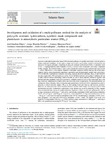Development and Validation of a Multi-Pollutant Method for the Analysis of Polycyclic Aromatic Hydrocarbons, Synthetic Musk Compounds and Plasticizers in Atmospheric Particulate Matter (PM₂.₅)

Use este enlace para citar
http://hdl.handle.net/2183/28709
A non ser que se indique outra cousa, a licenza do ítem descríbese como Atribución 4.0 Internacional (CC BY 4.0)
Coleccións
- GI-QANAP - Artigos [30]
Metadatos
Mostrar o rexistro completo do ítemTítulo
Development and Validation of a Multi-Pollutant Method for the Analysis of Polycyclic Aromatic Hydrocarbons, Synthetic Musk Compounds and Plasticizers in Atmospheric Particulate Matter (PM₂.₅)Autor(es)
Data
2021-07-18Cita bibliográfica
Joel Sánchez-Piñero, Jorge Moreda-Piñeiro, Carmen Moscoso-Pérez, Verónica FernándezGonzález, Darío Prada-Rodríguez, Purificación López-Mahía, Development and validation of a multi-pollutant method for the analysis of polycyclic aromatic hydrocarbons, synthetic musk compounds and plasticizers in atmospheric particulate matter (PM₂.₅), Talanta Open, Volume 4, 2021, 100057, ISSN 2666-8319, https://doi.org/10.1016/j.talo.2021.100057. (https://www.sciencedirect.com/science/article/pii/S2666831921000278)
Resumo
[Abstract] Exposure to atmospheric particulate matter (PM) associated pollutants is a global concern due to the risk posed in human health after inhalation. In this study, a simple and sensitive multi-residue method is developed for the analysis of 50 organic pollutants, comprising 18 polycyclic aromatic hydrocarbons (PAHs), 12 phthalate esters (PAEs), 12 organophosphorus flame retardants (OPFRs), 6 synthetic musk compounds (SMCs) and 2 bisphenols in PM₂.₅ samples. The method consists of three cycles of ultrasonic assisted solvent extraction and vortex (UASE + vortex), followed by a vortex-assisted dispersive solid phase extraction (d-SPE) clean-up and a final determination step by using programmed temperature vaporization-gas chromatography-tandem mass spectrometry (PTV-GC-MS/MS). Experimental conditions concerning clean-up adsorbents (alumina, silica gel and Florisil®) and filters (glass fibre, PTFE and nylon), as well as PTV-GC-MS/MS conditions were studied. In addition, the use of SRM (selected reaction monitoring) mode in MS-MS, as well as matrix-matched calibration together with labelled subrogate standards, resulted in successfully validation results for most of the compounds due to the high sensitivity, minimization of matrix effects and recovering losses compensation. The proposed method was validated in terms of linearity, limits of detection and quantification (LODs and LOQs), analytical recoveries by analysing a spiked composite sample (PM₂.₅) at three spiking levels and intra-day and inter-day precision. Moreover, an urban particulate matter standard reference material (SRM 1648a) was analysed to assess PAHs determination accuracy. Furthermore, applicability of the method was proved by analysing 12 PM₂.₅ samples from an industrial area. Among all studied pollutants, bisphenol A (BPA) was the most predominant with an average concentration of 5000 pg m⁻³, followed by bis(2-ethylhexyl) phthalate (DEHP) and diisobutyl phthtalate (DiBP) with 1990 pg m⁻³ and 632 pg m⁻³, respectively. Concerning OPFRs, average concentrations between 345 – 253 pg m⁻³ were found for triphenyl phosphine oxide (TPPO), tris(chloropropyl) phosphate (TCPP), tri-iso-butyl phosphate (TiBP) and tris(2-butoxyethyl) phosphate (TBOEP). Finally, the highest PAHs levels were found for 5-6 ring-number PAHs (Σ5-6 rings PAHs) with an average concentration of 2680 pg m⁻³, while only 2 SMCs were quantitated accounting for 17.5 pg m⁻³ by average.
Palabras chave
Polycyclic aromatic hydrocarbons
Phthalate esters
Organophosphorus flame retardants
Synthetic musk compounds
Bisphenols
Organic pollutants
Multi-residue method
Particulate matter
Phthalate esters
Organophosphorus flame retardants
Synthetic musk compounds
Bisphenols
Organic pollutants
Multi-residue method
Particulate matter
Versión do editor
Dereitos
Atribución 4.0 Internacional (CC BY 4.0)
ISSN
2666-8319






